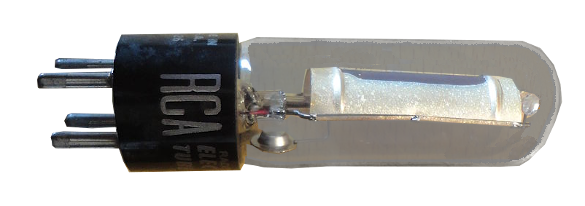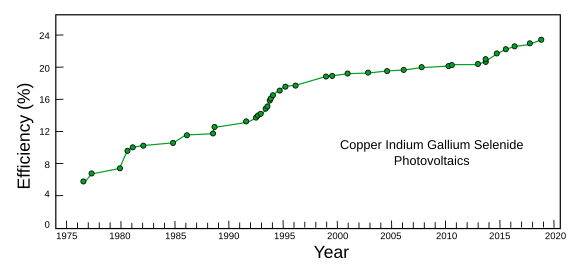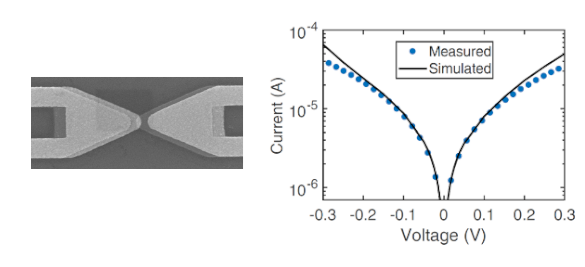Optical Rectenna
July 5, 2021
One of my first encounters with
electrical technology as a
child was at the local
A&P supermarket. which had an
automatic door operated by a
phototube, The phototube at one side of the
exitway was activated by a
focused light source at the other side. The light source was likely
modulated to allow a reliable detection with interfering light sources. It was no wonder that one of my first
electrical circuits was a light-operated
relay. The circuit was just the small relay connected to an
AC wall outlet in a
series connection with a
selenium photoconductive cell. Fortunately, electrical
experiments by children do not use such
dangerous voltages today.

An RCA 918 phototube. Phototubes are extremely simple devices. photons eject electrons from the surface of a photocathode, and these create a current with a nearby anode. The current is generally just a few microamperes, so amplification is needed in a device such as the door-opener described above. This particular phototube, which is ancient enough to have been used in this door-opener, had a peak response to light at about 850 nanometers, but it also had half that ssensitivity to red light, and a quarter that sensitivity in green light. It comes as no surprise that energetic ultraviolet photons produce a much stronger signal than the 850 nm infrared. (Modified Wikimedia Commons image by Grinevitski.)
Phototubes and selenium cells function by
photoconductivity, but a more useful
photo- phenomenon is the
photovoltaic effect in which light
energy is converted directly into electrical energy.
Solar energy generation is accomplished today through the use of photovoltaic cells, but development of the
inexpensive and
efficient photovoltaic cells we use today was nearly two
centuries in the making.
The photovoltaic effect was discovered in 1839 by
French physicist,
Edmond Becquerel (1820-1891), who was just 19 at the time. Doing
experiments in his
father's laboratory, Becquerel discovered the photovoltaic effect in the
silver halides,
silver chloride and
silver bromide, deposited on a
platinum electrode. Becquerel also employed such halides in the early development of
chemical photography. The state of photoconductive art was advanced in 1866 when
English electrical engineer,
Willoughby Smith (1828-1891),
accidentally discovered the photoconductivity of gray selenium while using it as a
semiconductor for testing
submarine cable.[1] As Smith explained,
I was induced to experiment with, bars of selenium, a known metal of very high resistance. I obtained several bars varying in length from 5 to 10 centimetres, and of a diameter from 1 to 1-1/2 millimetres. Each bar was hermetically sealed in a glass tube, and a platinum wire projected from each end for the purpose of connection.[1]
Much later, in 1877,
Kings College London professor,
William Grylls Adams (1836-1915), and his
student, Richard Day, observed the photovoltaic effect in selenium bars provided by Willoughby Smith.[2] A
candle placed an inch from a selenium bar produced a voltage, and the experimenters confirmed that this was a light effect, and it was not due to the
heat of the candle.[2] A few years later, in 1883,
Charles Fritts (1850-1903), a
New York inventor, coated selenium with a thin layer of
gold to create the first
solar cell.[3-4] The thin gold layer was somewhat
transparent, so it allowed light to reach the selenium surface, but it was
electrically conductive. This first solar cell had an
energy conversion efficiency of 1-2%.[2-4] Solar cells of
crystalline silicon were produced with 6% efficiency at
Bell Labs in 1954,[2] and such
expensive solar cells enabled
communications satellites, such as
Telstar.
The photovoltaics of choice for today's
solar panels are the inexpensive and efficient
thin-film photovoltaics based on
cadmium telluride and
copper indium gallium selenide. These function by photons causing electrons to jump across the
bandgap of a semiconductor
junction. Although not yet
commercialized,
perovskite solar cells are a possibly viable technology if their
robustness can be enhanced. I am personally not that excited about perovskites.

Energy conversion efficiencies of the best copper indium gallium selenide (CIGS) solar cells worldwide from 1976. (Data derived from a Wikimedia Commons image by Nikos Kopidakis of the National Renewable Energy Laboratory (NREL). Click for larger image.)
Light is an
electromagnetic wave, so harvesting light energy with an
antenna is also possible. The problems with this approach are that the
wavelength of
visible light is about 500
nanometers, so your antenna needs to be small; and, the minuscule
AC voltage obtained must be
rectified to produce a
direct current (DC). A team of
engineers from the
Department of Electrical, Computer and Energy Engineering at the
University of Colorado (Boulder, Colorado), has recently published its
research on a rectifying antenna they call a
rectenna for harvesting energy from the
infrared spectrum of light.[5-6] While this device is targeted for
harvesting heat energy, the same principle can be used for solar energy harvesting.
Since light-harvesting antennas must be small, they have high
resistance. This means a mismatch to the
impedance of free space and low efficiency. As for rectification of the voltage, traditional
Schottky diodes work well at low
frequencies, but their high resistance results in a cut-off frequency of about 40
GHz, far less than light frequency of about 30
terahertz (THz).[5-6] The solution to the rectification problem is the use a
quantum mechanical effect called
resonant tunneling by which electrons can traverse an
insulating gap without losing any energy.[6] Previous resonant tunnel junctions of metal-insulator-metal were limited to voltages an
order of magnitude too large for the 100 microvolts required for light-harvesting.[5] The junctions of the present study are a 100 times more efficient.[6]

Left, a scanning electron microscope image of the optical rectenna bow tie shape. Right, the current-voltage characteristic of the metal-double insulator-metal rectifier, with the black line showing the simulated response for a 4 nm NiO insulating layer. The reason you need 250,000 antennas is that a microamp and 10 millivolts is just 10 nanowatts. (Left image by the Moddel lab of the University of Colorado. Right image, fig. 2a of ref. 5, licensed under the Creative CommonsAttribution 4.0 International License.)
The rectifier junction in the present device has two insulators, not just one, and this creates a deep
quantum well. Electrons of a proper energy can
tunnel through the two insulators with no electrical resistance.[6] Says lead
author of the study,
Amina Belkadi, "If you choose your
materials right and get them at the right thickness, then it creates this sort of energy level where electrons see no resistance... They just go zooming through."[6] The resonant tunnel junction was constructed as
Ni/
NiO/
Al2O3/
Cr/
Au, and it had a resistance of 13
k-ohm and a
responsivity of 0.5 amps/
watt.[5]
The test device was an
array of about 250,000 bowtie rectennas, and it was tested using a
laboratory hot plate as an infrared source.[6] This device captured less than 1% of the hot plate heat, but there's always room for improvement.[6] Says Belkadi, "If we use different materials or change our insulators, then we may be able to make that well deeper,... The deeper the well is, the more electrons can pass all the way through.[6] One application aside from harvesting waste heat is to capture
Earth's radiation into the cold of
outer space.[6] I wrote about another method to do this in an
earlier article (Energy-Harvesting the Earth's Heat, March 10, 2014).
References:
- Willoughby Smith, "Effect of Light on Selenium During the Passage of An Electric Current," Nature, vol. 7 (February 20, 1873), p. 303, https://doi.org/10.1038/007303e0.
- W. G. Adams and R.E. Day, "The Action of Light on Selenium," Proceedings of the Royal Society, London, vol. A25 (January, 1877), p. 113, https://doi.org/10.1098/rspl.1876.0024.
- Discovery of the Photovoltaic (PV) Effect, solarcellcentral.com Web Site.
- Elizabeth Chu and D. Lawrence Tarazano, "A Brief History of Solar Panels," Smithsonian Magazine, April 22, 2019.
- Amina Belkadi, Ayendra Weerakkody, and Garret Moddel, "Demonstration of resonant tunneling effects in metal-double-insulator-metal (MI2M) diodes," Nature Communications, vol. 12, Article no. 2925 (May 18, 2021), https://doi.org/10.1038/s41467-021-23182-0. This is an open access article with a PDF file here.
- Daniel Strain, "Scientists debut world’s most efficient 'optical rectennas,' devices that harvest power from heat, University of Colorado Press Release, May 18, 2021.
Linked Keywords: Electricity; technology; child; The Great Atlantic & Pacific Tea Company; A&P; supermarket; automatic; door; phototube; portal (architecture); exitway; focus (optics); focused; light source; amplitude modulation; modulated; electrical circuit; relay; AC wall outlet; series circuit; series connection; selenium; photoresistor; photoconductive cell; experiment; hazard; dangerous; voltage; RCA; photon; photoelectric effect; electron; surface; photocathode; electric current; anode; microampere; amplifier; amplification; spectrum; peak response; light; nanometer; sensitivity (electronics); energy; energetic; ultraviolet; infrared; Wikimedia Commons; photoconductivity; phenomenon; photovoltaic effect; Solar energy generation; cost; inexpensive; energy conversion efficiency; efficient; century; centuries; French; physicist; Edmond Becquerel (1820-1891); experiment; father; laboratory; silver halide; silver chloride; silver bromide; platinum; electrode; chemical reaction; photography; English; electrical engineering; electrical engineer; Willoughby Smith (1828-1891); serendipity; accident; semiconductor; submarine communications cable; metal; electrical resistance; centimetres; hermetic seal; glass; tube (container; Kings College London; professor; William Grylls Adams (1836-1915); student; candle; heat; Charles Fritts (1850-1903); New York City; invention; inventor; gold; solar cell; transparency; transparent; electrical conductor; electrically conductive; crystal; crystalline; silicon; Bell Labs; communications satellite; Telstar; solar panel; thin-film solar cell; thin-film photovoltaic; cadmium telluride; copper indium gallium selenide; bandgap; P-N junction; commercialization; commercialize; perovskite solar cell; resilience; robustness; CIGS solar cell; Nikos Kopidakis; National Renewable Energy Laboratory (NREL); electromagnetic radiation; electromagnetic wave; antenna (radio); wavelength; visible spectrum; visible light; nanometer; alternating current; AC; rectifier; rectified; direct current (DC); engineer; Department of Electrical, Computer and Energy Engineering; University of Colorado (Boulder, Colorado); research; infrared spectrum; energy harvesting; harvesting heat energy; electrical resistance; impedance of free space; Schottky diode; frequency; frequencies; hertz; GHz; terahertz (THz); quantum mechanics; quantum mechanical; resonant-tunneling diode; resonant tunneling; insulator (electricity); insulating; order of magnitude; scanning electron microscope; micrograph; optics; optical; bow tie; current-voltage characteristic; metal; insulator (electrical); simulation; simulated; Nickel(II) oxide; NiO; millivolt; nanowatt; Moddel lab of the University of Colorado; Creative CommonsAttribution 4.0 International License; quantum well; quantum tunnelling; author; Amina Belkadi; material; nickel; Ni; Nickel(II) oxide; NiO; aluminium oxide; Al2O3; chromium; Cr; gold; Au; ohm; k-ohm; energy transformation; responsivity; watt; antenna array; laboratory; hot plate; Earth; black-body radiation; outer space.